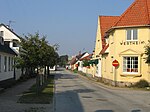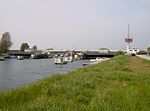Skanör Church
12th-century churches in SwedenChurches converted from the Roman Catholic Church to the Church of SwedenChurches in Skåne CountyChurches in the Diocese of LundChurches in the Øresund Region ... and 1 more
Gothic architecture in Sweden

Skanör Church (Swedish: Skanörs kyrka, also known as the Church of St. Olof, Swedish: S:t Olofs kyrka) is a medieval Lutheran church at Skanör in Vellinge Municipality, Skåne County, Sweden. It is associated with the Skanör-Falsterbo parish (Skanör-Falsterbo församling) in the Diocese of Lund within the Church of Sweden.
Excerpt from the Wikipedia article Skanör Church (License: CC BY-SA 3.0, Authors, Images).Skanör Church
Östra Kyrkogatan, Vellinge kommun
Geographical coordinates (GPS) Address External links Nearby Places Show on map
Geographical coordinates (GPS)
| Latitude | Longitude |
|---|---|
| N 55.419722222222 ° | E 12.849722222222 ° |
Address
Skanörs kyrka
Östra Kyrkogatan
239 30 Vellinge kommun, Skanör
Sweden
Open on Google Maps







